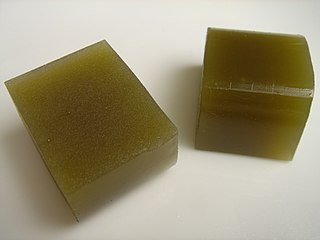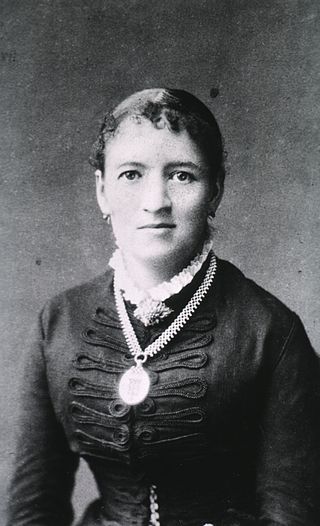
Agar, or agar-agar, is a jelly-like substance consisting of polysaccharides obtained from the cell walls of some species of red algae, primarily from "ogonori" (Gracilaria) and "tengusa" (Gelidiaceae). As found in nature, agar is a mixture of two components, the linear polysaccharide agarose and a heterogeneous mixture of smaller molecules called agaropectin. It forms the supporting structure in the cell walls of certain species of algae and is released on boiling. These algae are known as agarophytes, belonging to the Rhodophyta phylum. The processing of food-grade agar removes the agaropectin, and the commercial product is essentially pure agarose.

An agar plate is a Petri dish that contains a growth medium solidified with agar, used to culture microorganisms. Sometimes selective compounds are added to influence growth, such as antibiotics.

A microbiological culture, or microbial culture, is a method of multiplying microbial organisms by letting them reproduce in predetermined culture medium under controlled laboratory conditions. Microbial cultures are foundational and basic diagnostic methods used as research tools in molecular biology.

A blood culture is a medical laboratory test used to detect bacteria or fungi in a person's blood. Under normal conditions, the blood does not contain microorganisms: their presence can indicate a bloodstream infection such as bacteremia or fungemia, which in severe cases may result in sepsis. By culturing the blood, microbes can be identified and tested for resistance to antimicrobial drugs, which allows clinicians to provide an effective treatment.

A growth medium or culture medium is a solid, liquid, or semi-solid designed to support the growth of a population of microorganisms or cells via the process of cell proliferation or small plants like the moss Physcomitrella patens. Different types of media are used for growing different types of cells.
Industrial fermentation is the intentional use of fermentation in manufacturing processes. In addition to the mass production of fermented foods and drinks, industrial fermentation has widespread applications in chemical industry. Commodity chemicals, such as acetic acid, citric acid, and ethanol are made by fermentation. Moreover, nearly all commercially produced industrial enzymes, such as lipase, invertase and rennet, are made by fermentation with genetically modified microbes. In some cases, production of biomass itself is the objective, as is the case for single-cell proteins, baker's yeast, and starter cultures for lactic acid bacteria used in cheesemaking.

In microbiology, streaking is a technique used to isolate a pure strain from a single species of microorganism, often bacteria. Samples can then be taken from the resulting colonies and a microbiological culture can be grown on a new plate so that the organism can be identified, studied, or tested.

Trypticase soy agar or Tryptic soy agar (TSA) is a growth media for the culturing of moderately to non fastidious bacteria. It is a general-purpose, non-selective media providing enough nutrients to allow for a wide variety of microorganisms to grow. It is used for a wide range of applications, including culture storage, enumeration of cells (counting), isolation of pure cultures, or simply general culture.

Potato dextrose agar and potato dextrose broth are common microbiological growth media made from potato infusion and dextrose. Potato dextrose agar is the most widely used medium for growing fungi and bacteria.

Etest is a way of determining antimicrobial sensitivity by placing a strip impregnated with antimicrobials onto an agar plate. A strain of bacterium or fungus will not grow near a concentration of antibiotic or antifungal if it is sensitive. For some microbial and antimicrobial combinations, the results can be used to determine a minimum inhibitory concentration (MIC). Etest is a proprietary system manufactured by bioMérieux. It is a laboratory test used in healthcare settings to help guide physicians by indicating what concentration of antimicrobial could successfully be used to treat patients' infections.

Nutrient agar is a general-purpose solid medium supporting growth of a wide range of non-fastidious organisms. It typically contains (mass/volume):
Middlebrook 7H9 broth is a liquid growth medium specially used for culture of Mycobacterium species, notably Mycobacterium tuberculosis.
Middlebrook 7H10 Agar is a solid growth medium specially used for culture of Mycobacterium, notably Mycobacterium tuberculosis. It has been reported that the 7H10 medium tends to grow fewer contaminants than the egg-based media commonly used for the cultivation of mycobacteria.
Tryptic soy broth or Trypticase soy broth is used in microbiology laboratories as a culture broth to grow aerobic and facultative anaerobic bacteria. It is a general purpose medium that is routinely used to grow bacteria which tend to have high nutritional requirements.
A fastidious organism is any organism that has complex or particular nutritional requirements. In other words, a fastidious organism will only grow when specific nutrients are included in its medium. The more restrictive term fastidious microorganism is used in microbiology to describe microorganisms that will grow only if special nutrients are present in their culture medium. Thus fastidiousness is often practically defined as being difficult to culture, by any method yet tried.

Fanny Hesse is best known for her work in microbiology alongside her husband, Walther Hesse. Following her initial suggestion of using agar as an alternative to gelatin, they were instrumental in pioneering agar's usage as a common gelling agent for producing media capable of culturing microorganisms at high temperatures.

Granada medium is a selective and differential culture medium designed to selectively isolate Streptococcus agalactiae and differentiate it from other microorganisms. Granada Medium was developed by Manuel Rosa-Fraile et al. at the Service of Microbiology in the Hospital Virgen de las Nieves in Granada (Spain).
In microbiology, the term isolation refers to the separation of a strain from a natural, mixed population of living microbes, as present in the environment, for example in water or soil, or from living beings with skin flora, oral flora or gut flora, in order to identify the microbe(s) of interest. Historically, the laboratory techniques of isolation first developed in the field of bacteriology and parasitology, before those in virology during the 20th century.

An inoculation needle is a laboratory equipment used in the field of microbiology to transfer and inoculate living microorganisms. It is one of the most commonly implicated biological laboratory tools and can be disposable or re-usable. A standard reusable inoculation needle is made from nichrome or platinum wire affixed to a metallic handle. A disposable inoculation needle is often made from plastic resin. The base of the needle is dulled, resulting in a blunted end.
Schädler agar is a nutrient-rich growth medium primarily used in microbiology for the cultivation of anaerobic bacteria. It was developed to support the growth of a wide variety of anaerobic organisms, providing a conducive environment for both fastidious and non-fastidious anaerobes. The medium contains a combination of peptones, yeast extract, and other nutrients that create an optimal growth environment. Additionally, reducing agents such as cysteine and sodium thioglycolate are included to maintain the anaerobic conditions necessary for the survival of these bacteria.













